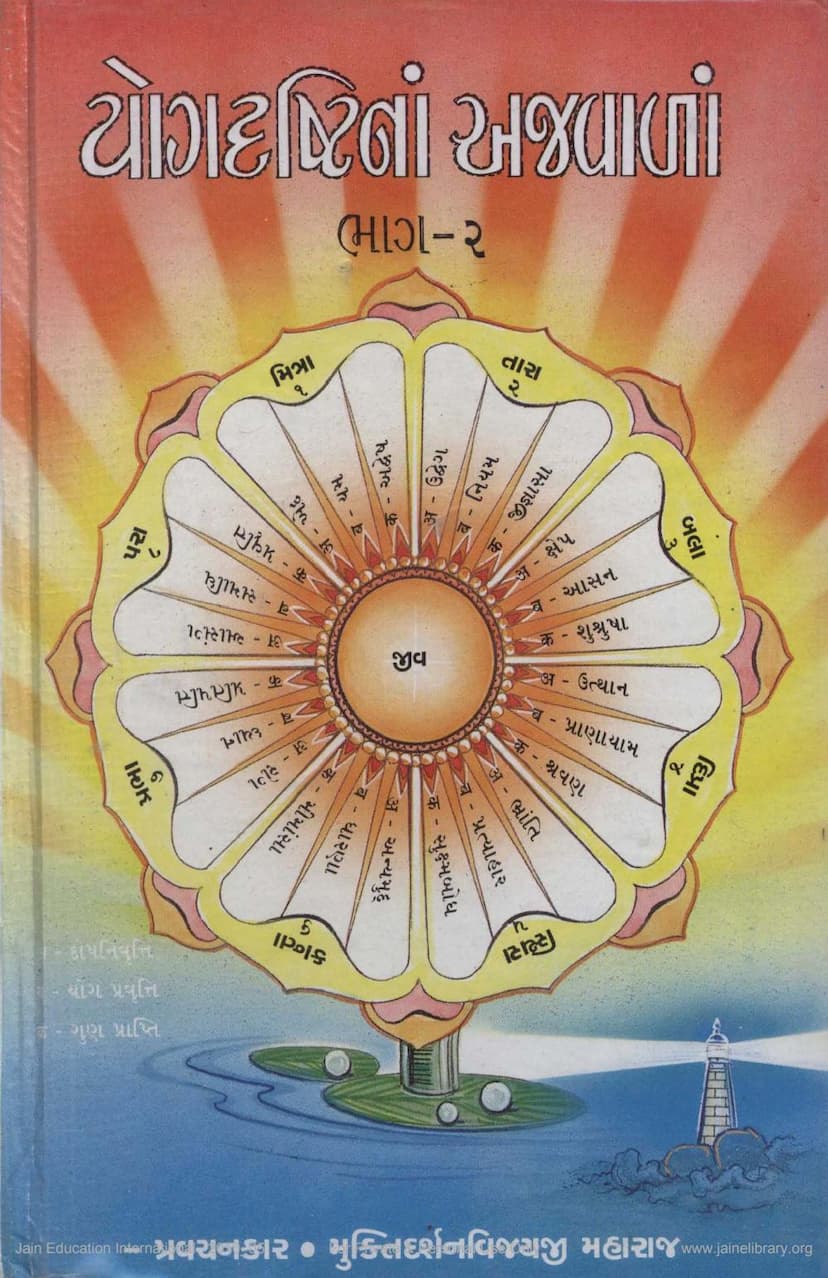Yogadraushtina Ajwala Part 2
Added to library: September 2, 2025

Summary
Based on the provided text, here's a comprehensive summary of the Jain text "Yogadraushtina Ajwala Part 2" by Muktidarshanvijay:
Book Title: Yogadraushtina Ajwala Part 2 Author: Muktidarshanvijay Publisher: Vardhaman Seva Nidhi Mumbai Catalog Link: https://jainqq.org/explore/004612/1
This book, "Yogadraushtina Ajwala Part 2," is a detailed commentary and elaboration on the Jain text "Yogadrashti Samuccaya," authored by the revered Acharya Haribhadrasuri Maharaaja. The present volume covers verses 17 to 56 of the original text.
Core Themes and Content:
The book delves into the profound philosophy of Yoga as expounded in Jainism, specifically through the lens of Haribhadrasuri's "Yogadrashti Samuccaya." It explains the concept of "Yogadrashti" (Yoga vision) and its classification into eight stages or perspectives. The second part of this commentary focuses on the latter four "drashtis" (visions) in comparison to the first four, explaining why the first four are considered "sapaya" (with support or conditional) and the latter four are "nirapaya" (without support or unconditional).
The central message revolves around the progressive journey of the soul towards spiritual development and liberation through Yoga. The text systematically outlines the gradual ascent through the stages of Yoga, highlighting the destruction of negative tendencies like mithyatva (wrong belief), avirati (non-restraint), kashaya (passions), and yoga (activity/action) through the understanding and practice of the eight drashtis.
Key Concepts and Explanations:
- The Eight Yogic Visions (Drashtis): The book elaborates on the eight specific visions of Yoga outlined by Haribhadrasuri. These are presented in a progression, starting from Mitra (friendly) and moving towards Para (transcendent). The text explains how each stage helps in overcoming specific obstacles and achieving spiritual growth.
- Yama and Niyama: The foundational ethical principles of Yoga.
- Asana and Pranayama: Postures and breath control techniques.
- Pratyahara and Dharana: Withdrawal of senses and concentration.
- Dhyana and Samadhi: Meditation and deep absorption.
- Doshanyavrittti (Vitaragta): The cessation of passions.
- Drishtis and their Qualities: The book likely explores the qualities of each of the eight visions, moving from ignorance and attachment towards knowledge and detachment.
- Jain Perspective on Yoga: The text emphasizes that the Jain approach to Yoga is distinct from other philosophical traditions. It stresses the importance of strict ethical conduct (achar) as a fundamental prerequisite for the practice and development of Yoga, rather than mere physical postures or chanting.
- Overcoming Samskaras: The book explains that the deep-rooted negative tendencies (samskaras) accumulated over infinite lifetimes cannot be simply removed by external practices. It highlights the need for inner transformation, becoming virtuous, wise, and compassionate.
- The Importance of Inner Transformation: The teachings emphasize the need to abandon negative tendencies like jealousy, slander, hatred, and criticism, which can lead to spiritual downfall.
- Nishchay and Vyavahar (Ultimate Truth and Conventional Truth): The book clarifies the often-confusing terms of nishchay (ultimate truth) and vyavahar (conventional truth) within the context of Yoga, explaining how maintaining both is crucial for spiritual progress. It defines vyavahar as not giving suffering to others, and nishchay as maintaining one's own inner peace and happiness.
- The Essence of Self-Realization: The core message of the lectures is the realization and experience of one's true self (swaroop). This is achieved through diligent adherence to the principles of conduct and inner awareness.
- Practical Application: The text draws parallels from the lives of historical figures like Bharat Chakravarti and Shalu Kumar to simplify complex philosophical concepts, making the path of Yoga accessible and relatable. It also emphasizes the importance of cultivating virtues like humility, compassion, and detachment.
- Guidance and Inspiration: The book is presented as a guide and inspiration for those seeking to progress on the spiritual path of Yoga within the Jain tradition. It acknowledges the guidance of Acharya Jayghosh Suri Maharaja and the research contributions of Muni Udayvallabh Vijayji.
Overall Purpose:
"Yogadraushtina Ajwala Part 2" aims to illuminate the path of Yoga for the spiritual aspirant, emphasizing the systematic and gradual progression towards self-realization and liberation. It provides practical insights into cultivating inner virtues and overcoming the obstacles that hinder spiritual growth, all within the framework of Jain philosophy and practice. The book encourages readers to look within and develop their inner nature to attain equanimity and ultimately, liberation.